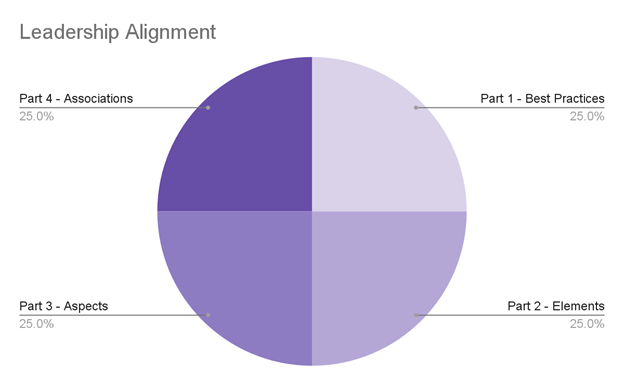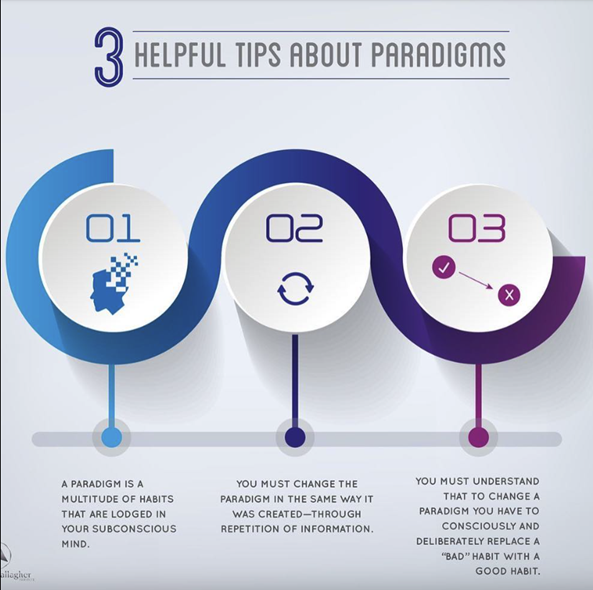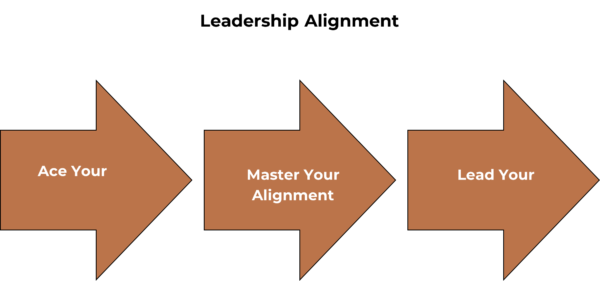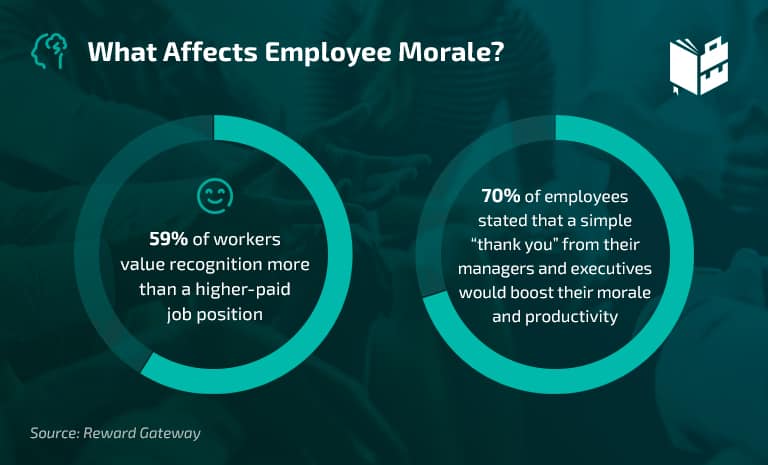Leadership Alignment

The Appleton Greene Corporate Training Program (CTP) for Leadership Alignment is provided by Ms. Gnago Certified Learning Provider (CLP). Program Specifications: Monthly cost USD$2,500.00; Monthly Workshops 6 hours; Monthly Support 4 hours; Program Duration 24 months; Program orders subject to ongoing availability.

Personal Profile
Ms. Gnago develops and leads Talent Development and Training Management initiatives in a variety of industries. She has extensive experience training professionals at all levels, from line employees to executives to board members. She holds a Master of Business Administration degree along with several certifications related to Professional Development specifically focused on soft and essential skills.
Ms. Gnago’s expansive experiences include a range of roles in performance management, job analyses, professional and talent development/management and training facilitation for thousands of professionals at all levels. Over the course of 25+ years she has created, enhanced and managed programs, developed a competency, and led project teams from inception to project and goal achievement. Ms. Gnago has also set and implemented strategic planning for professional associations and U.S. state agencies. Her exposure to a number of industries includes Economic Consulting, Educational Institutions, State Government, Financial Services, Convention Management and Professional Associations. Plus, she has been involved in leading advisory and Board Leadership service operating in a variety of roles.
After several years helping individuals and organizations she developed the skill set of Alignment as a competency, so it can be leveraged for career wellbeing and career experience management.
This competency:
– Upskills {emerging} leaders and/or those wanting to elevate their leadership skills, transferable to any environment. It helps professionals interested in upgrading their career progression standards and access unique strategies that re-engage the value of investing in themselves.
– Happens to serve as an asset to those finding themselves in DEI-challenged dynamics. It helps all professionals with cultivating their Alignment and thrive professionally.
Ms. Gnago has single-handedly authored three compelling books, a workbook and an annual blog, all related to the Alignment competency she developed. She has published and guest-starred on podcast episodes and has spoken at conferences. Ms. Gnago also creates workshops and course offerings (including a masterclass) on this expertise for organizations interested in educating their team members and providing them with support to their coaching and training programs.
Externally to this line of work, Ms. Gnago has also been involved in developing and maintaining engagement projects with regional leaders in corporate and industry-specific businesses, community-based non-profits, government agencies, and other relevant groups for business engagement purposes. Her projects focused on leading, planning and implementing specific initiatives to create and develop opportunities related to workforce development. Ms. Gnago has moderated panels and managed workshop facilitation including roundtables, briefing sessions, focus groups, networking events, media launches, and outreach strategies. For outcomes measurement, she has also reconciled metrics reporting and related activities.
To request further information about Ms. Gnago through Appleton Greene, please Click Here.
(CLP) Programs
Appleton Greene corporate training programs are all process-driven. They are used as vehicles to implement tangible business processes within clients’ organizations, together with training, support and facilitation during the use of these processes. Corporate training programs are therefore implemented over a sustainable period of time, that is to say, between 1 year (incorporating 12 monthly workshops), and 4 years (incorporating 48 monthly workshops). Your program information guide will specify how long each program takes to complete. Each monthly workshop takes 6 hours to implement and can be undertaken either on the client’s premises, an Appleton Greene serviced office, or online via the internet. This enables clients to implement each part of their business process, before moving onto the next stage of the program and enables employees to plan their study time around their current work commitments. The result is far greater program benefit, over a more sustainable period of time and a significantly improved return on investment.
Appleton Greene uses standard and bespoke corporate training programs as vessels to transfer business process improvement knowledge into the heart of our clients’ organizations. Each individual program focuses upon the implementation of a specific business process, which enables clients to easily quantify their return on investment. There are hundreds of established Appleton Greene corporate training products now available to clients within customer services, e-business, finance, globalization, human resources, information technology, legal, management, marketing and production. It does not matter whether a client’s employees are located within one office, or an unlimited number of international offices, we can still bring them together to learn and implement specific business processes collectively. Our approach to global localization enables us to provide clients with a truly international service with that all important personal touch. Appleton Greene corporate training programs can be provided virtually or locally and they are all unique in that they individually focus upon a specific business function. All (CLP) programs are implemented over a sustainable period of time, usually between 1-4 years, incorporating 12-48 monthly workshops and professional support is consistently provided during this time by qualified learning providers and where appropriate, by Accredited Consultants.
Executive summary
Leadership Alignment
This Leadership Alignment program is an exceptional personal mastery self-leadership tool designed to help guide professionals through their leadership journey. It particularly focuses on managing thoughts, actions, and emotions to achieve goals and foster constructive, collaborative, and positive outcomes. In order for leaders to be distinguished as the skilled and competent professionals they are amongst others of their caliber, they must learn circumstantial management skills to transform themselves into the leaders they wish they were and one others wish they had. They must learn how to operate from a place of alignment, as the best version of themselves, and how to set their tone to strategically impact their environments. The result is a focus on innovation and growth rather than grappling with unnecessary challenges that stem from unresolved issues among professionals when times are difficult. This is achieved by leaders leveraging their sense of self, maintaining their composure and resilience, and leaning on cooperation.
Oftentimes, this happens: A professional is good at their job and receives a promotion based on their performance and the output they have produced effectively. Then, they earn their promotion to the next level and, with a job title in management or leadership, they are then expected to know how to manage others while navigating the nuances of the work environment at that new level. They learn through trial and error and experience and, when training is available, they are enrolled in learning programs to help solidify their position. However, for various reasons, this typically occurs too late, as investments in leadership learning and development are often made only after a professional is promoted.
To stay ahead, it is crucial for leaders to receive this type of training and skills early on. This ensures that by the time they reach leadership positions, they are already well-prepared to lead and manage others effectively, having gained the necessary skills and experience in advance.
This program elevates the thought-process of leaders and provides some structure around developing best practices essential for success in leadership roles. Participants learn alignment as a tool for success and ongoing progression. Participants will benefit from a mindset perspective that, when understood and leveraged effectively, serves as a guiding system for excelling as a leader. A variety of topics leaders encounter over the course of their careers lifetimes will be explored and learned. Discussions, activities, real-world examples, presentations and other elements will be leveraged to ensure adult learners are able to engage their own experiences throughout the duration of this program.
Participation in this program encourages leaders to self-assess where participants:
● Gain insights into their current leadership styles, strengths and areas for improvement
● Define clear and actionable goals that align with their personal values and organizational objectives
● Manage their thoughts so that they leverage cognitive behavioral strategies and understand mental conditioning and how it impacts their leadership
● understand their emotions, how they impact their decisions and how they can leverage composure and resilience
● Create actionable plans that align with goals and ensure consistent progress while encouraging effective decision making
● Regular reflection on progress to make necessary adjustments

Participants learn to develop their strategic thinking acumen and how to best align themselves to the company cultures they join from a place of alignment. They will learn about a variety of topics, attend an external seminar, conduct activities and discussions, take assessments, learn from guest speakers or panels, learn from books and templates, network and provide their own perspectives though discussions. This comprehensive program will help them with aligning themselves to strategic leadership.
At the end of the program, participants will have learned transferable skills that revolve around alignment and best practices, elements and aspects of leadership and the benefits of effective associations. They will experience a strong sense of alignment with their new role and come away with a formula to thrive in any environment.
The Importance of Leadership Alignment: A Strategic Investment
Leadership alignment is more than a management strategy; it is a foundational element for organizational success. In a rapidly evolving business environment marked by complex challenges and competitive pressures, investing time and resources into leadership alignment can transform an organization from reactive to proactive. Here’s why leadership alignment should be a top priority for businesses and leaders.
Driving Organizational Clarity and Focus:Leadership alignment ensures that all leaders within an organization are united in their vision, values, and strategic goals. When leaders are aligned, they provide clear, consistent direction to their teams, eliminating confusion and fostering a unified approach toward achieving objectives. This clarity cascades through all levels of the organization, enabling employees to focus on their roles without ambiguity. It creates a coherent structure where resources, time, and energy are concentrated on high-impact initiatives.
Enhancing Employee Engagement and Retention:Misaligned leadership often results in inconsistent messaging, conflicting priorities, and low morale among employees. Research shows that employees are more engaged and likely to stay with organizations where leadership demonstrates unity, clear purpose, and support for their professional development. By aligning leadership teams, businesses can cultivate a workplace culture that prioritizes collaboration, innovation, and mutual respect—key factors in reducing turnover and retaining top talent.
Boosting Decision-Making and Agility:Aligned leadership fosters a shared decision-making framework that reduces friction and improves efficiency. With a unified approach, leaders can make faster, more informed decisions that align with the organization’s long-term goals. This is particularly critical in today’s fast-paced business environment, where agility and adaptability are essential for responding to emerging trends, market disruptions, or unexpected challenges.
Maximizing Financial Performance:Leadership alignment has a direct impact on an organization’s bottom line. A study by McKinsey & Company found that organizations with aligned leadership teams are up to 2.4 times more likely to outperform their competitors financially. By aligning their efforts, leaders can better manage resources, streamline operations, and avoid costly missteps. This focus on strategic alignment ensures that every initiative contributes to profitability and sustained growth.
Creating a Resilient and Adaptive Culture:Businesses that prioritize leadership alignment are better equipped to navigate periods of change and uncertainty. Aligned leaders set the tone for resilience and adaptability, demonstrating to their teams how to remain focused and innovative in the face of adversity. This cultural strength becomes a competitive advantage, enabling the organization to thrive even in volatile market conditions.
Addressing Common Pain Points
Leadership misalignment often leads to inefficiencies, stalled growth, and missed opportunities. By prioritizing alignment, businesses can address common issues such as poor communication, team conflicts, lack of strategic focus, and resistance to change. Aligned leaders act as role models, fostering trust and collaboration across departments, which in turn drives organizational success.
Allocating resources and time to leadership alignment is not a luxury; it is a strategic necessity. Organizations that invest in aligning their leadership teams see measurable benefits, from improved employee engagement to enhanced financial performance and long-term resilience. By making leadership alignment a priority, businesses position themselves to achieve sustainable success in an increasingly competitive world. It is a proactive step that empowers leaders, galvanizes teams, and drives meaningful results.

Case Study: Microsoft’s Leadership Alignment Journey
In 2014, Satya Nadella became CEO of Microsoft, stepping into a company that, while financially robust, faced significant internal challenges. Leadership misalignment had created silos, conflicting priorities, and a stagnating culture. These issues hampered Microsoft’s ability to innovate and adapt to an increasingly agile and competitive tech landscape. Recognizing the need for change, Nadella made leadership alignment a strategic priority.
Nadella’s approach to aligning Microsoft’s leadership began with establishing a unified vision and mission. He articulated a clear purpose: to “empower every person and every organization on the planet to achieve more.” This vision served as a north star, anchoring strategic decisions and ensuring alignment across all departments and geographies.
Cultural transformation was the next critical step. Nadella emphasized shifting Microsoft’s mindset from a “know-it-all” culture to a “learn-it-all” mentality. Leaders were encouraged to embrace curiosity, collaboration, and a customer-first approach. Leadership development programs and regular forums facilitated this cultural change, fostering a shared understanding and commitment among leaders.
Strategic collaboration was also a key focus. Siloed leadership structures were dismantled, with leaders aligned on shared goals like advancing cloud computing and integrating AI into Microsoft’s products. Initiatives such as the unification of cloud services through Azure required cross-functional cooperation, reinforcing alignment through shared accountability.
Outcomes
The results of Microsoft’s leadership alignment efforts were transformative. A renewed corporate culture emerged, characterized by collaboration and continuous learning. Employee engagement scores saw a 23% increase by 2019, reflecting the positive impact of the cultural shift.
Innovation flourished under aligned leadership. Azure became a leading cloud platform, propelling Microsoft to the forefront of cloud computing and AI. Between 2014 and 2021, Microsoft’s market capitalization skyrocketed from $300 billion to over $2 trillion. Revenue grew from $86 billion in 2014 to $168 billion in 2021, with significant improvements in profitability due to the focus and efficiency brought by leadership alignment.
Microsoft’s transformation illustrates the power of leadership alignment in driving organizational success. By uniting leaders around a shared vision, fostering a culture of collaboration, and ensuring strategic cohesion, the company not only revitalized its culture but also became an industry leader in innovation and growth. This case study demonstrates the tangible benefits of investing in leadership alignment, offering a compelling example for organizations seeking to achieve sustainable success.
Pain Points Leadership Alignment Can Address
Leadership alignment is not just an aspirational concept but a practical solution to some of the most pressing challenges faced by organizations today. Misaligned leadership often creates ripple effects throughout the organization, impacting team dynamics, productivity, and long-term growth. Below are key pain points that leadership alignment addresses, ensuring leaders operate effectively, cohesively, and with purpose.
Without alignment, leaders often adopt a reactive style, focusing on resolving immediate crises instead of anticipating challenges and proactively driving growth. This short-term mindset leads to inefficiencies, burnout, and missed opportunities. Leadership alignment fosters a proactive approach, enabling leaders to think strategically, plan effectively, and prioritize actions that generate long-term value.
Misalignment at the leadership level frequently trickles down to teams, creating confusion, conflict, and inefficiency. When leaders are not on the same page, it disrupts communication, weakens trust, and hinders collaboration. By fostering alignment, organizations can ensure that leaders set clear expectations, model cohesive behavior, and create an environment where teams can thrive.
Leadership is as much about managing people as it is about managing tasks. Leaders who struggle to regulate their emotions or respond empathetically can negatively impact team morale and cohesion. Leadership alignment emphasizes emotional intelligence, equipping leaders with the skills to manage emotions, navigate difficult conversations, and foster a positive work atmosphere.
In a fast-paced work environment, leaders are often overwhelmed by the volume of decisions they must make daily. This cognitive overload can lead to poor judgment, decreased productivity, and frustration. Leadership alignment streamlines decision-making by fostering clarity in priorities, reducing mental strain, and enabling leaders to focus on high-impact areas.
Misaligned leaders tend to focus on immediate tasks and short-term objectives, often at the expense of long-term strategy. This lack of vision can stagnate organizational growth and limit innovation. Leadership alignment encourages leaders to think beyond day-to-day operations, aligning their actions with the organization’s overarching goals and driving sustained success.
In rapidly evolving industries, the ability to adapt is crucial. Misaligned leadership often results in resistance to change, as individuals cling to familiar processes or struggle to embrace new approaches. Leadership alignment fosters an adaptive mindset, empowering leaders to navigate transitions effectively and inspire their teams to do the same.
When leaders operate without alignment, it can undermine organizational values and contribute to a toxic work environment. Misaligned leadership often results in inconsistent messaging, favoritism, or a lack of accountability. By promoting alignment, leaders can reinforce cultural values, establish trust, and create an inclusive and supportive workplace.
Leaders who lack alignment often stagnate in their personal and professional development, limiting opportunities for advancement. Leadership alignment helps individuals identify growth areas, build their competencies, and position themselves for continued success within the organization.
Inconsistent messaging and unclear priorities can strain relationships with internal and external stakeholders. Leadership alignment ensures that leaders communicate effectively, articulate a unified vision, and build trust with their audiences, enhancing collaboration and credibility.
Addressing these pain points through leadership alignment not only improves individual effectiveness but also strengthens the entire organization, fostering a culture of collaboration, resilience, and sustained growth.
Curriculum
Leadership Alignment – Part 1- Year 1
- Part 1 Month 1 Professional Journey
- Part 1 Month 2 Leadership Confidence
- Part 1 Month 3 Occupation Alignment
- Part 1 Month 4 Professional Judgement
- Part 1 Month 5 Professional Alignment
- Part 1 Month 6 Leadership & Inclusion
- Part 1 Month 7 Leadership Caliber
- Part 1 Month 8 Leadership Styles
- Part 1 Month 9 Resourcefulness & Creativity
- Part 1 Month 10 Emotional Intelligence
- Part 1 Month 11 Capstone Project Overview and Networking
- Part 1 Month 12 Workplace Awareness
Leadership Alignment – Part 2- Year 2
- Part 2 Month 1 Personality Assessments
- Part 2 Month 2 Managing Mindsets
- Part 2 Month 3 Corporate Sportsmanship
- Part 2 Month 4 Public Speaking
- Part 2 Month 5 Resilience & Flexibility
- Part 2 Month 6 Leveraging Allies
- Part 2 Month 7 Maintaining Trust
- Part 2 Month 8 Motivation and Rewards
- Part 2 Month 9 Red Tape
- Part 2 Month 10 Leveraging Expertise
- Part 2 Month 11 Succession Planning
- Part 2 Month 12 Capstone Presentation
Program Objectives
The following list represents the Key Program Objectives (KPO) for the Appleton Greene Leadership Alignment corporate training program.
Leadership Alignment – Part 1- Year 1
- Part 1 Month 1 Professional Journey – The journey toward professional excellence begins with clarity—an essential element for achieving personal and career transformation. Workshop 1 introduces participants to foundational concepts from Laëtitia Gnago’s Ace Your Professional Journey, a practical guide for cultivating self-awareness, building confidence, and unlocking professional potential. Drawing from her experiences and insights from accomplished leaders, Gnago provides a structured pathway to help individuals understand and optimize their workplace contributions, ultimately fostering growth and fulfillment. This workshop sets the tone for the entire program, diving into the mental frameworks, values, and strategies required for professionals to excel as individuals and within their organizations. Participants are introduced to the “Ace mindset,” a transformative perspective that emphasizes positivity, adaptability, and proactive engagement. Through relatable anecdotes and actionable strategies, they’ll learn how to navigate workplace dynamics, leverage opportunities, and establish themselves as trusted, high-performing leaders. Central to this workshop are the eight foundational phases outlined in Gnago’s book, which provide a clear roadmap for professional success. Beginning with Discovery and Awareness, participants learn to assess their environment, identify key influencers, and understand workplace culture. The importance of crafting a compelling Vision is then explored, where participants define what success looks and feels like and how this vision catalyzes meaningful change. By the end of this workshop, participants will leave with a structured framework for personal and professional growth, the tools to align their ambitions with their actions, and the confidence to navigate their careers with intention and purpose. This workshop forms the bedrock for the transformational journey ahead.
- Part 1 Month 2 Leadership Confidence – A confident leader is able to evoke the most out of their team members and colleagues – we will discuss confidence building: techniques to strengthen one’s professional confidence and self-belief using examples from the book: Ace Your Professional Journey, by Laëtitia Gnago. We discuss the ways in which confidence at work impacts important aspects of the working experience: performance, promotional opportunities and overall career wellbeing. Specific techniques are explained including the impact of assessing one’s environment, how creating leadership intentions and goals helps influence experiences, and the importance of having a vision for our leadership experience. Behaviors that display confidence are explored as well as a strategy for maintaining it, regardless of the workplace atmospheres we may find ourselves in. Participants will engage in a set of activities to learn how to cultivate success, build trust, boost productivity and increase workplace wellness leading to career experience improvement. The result: participants learn what engaging with others confidently looks like and best practices for maintaining it
- Part 1 Month 3 Occupation Alignment – Aligning with a specific field entails more than securing its academic options and having experience working in the industry – Creating alignment is an approach all leaders leverage. How? By understanding how to anchor specific strategies that help in being productive and effective. Compatibility, innovation, compliance and quality of work outputs are some of the notions that can impact measurement. We discuss industry alignment opportunities that includes how to ensure compliance with external standards and regulations, and how to position our work with industry trends and client expectations. The role of strategic alignment within one’s industry involves synchronizing goals and objectives with per diem operations as a game plan. When this is done effectively, the leadership vision is intertwined with the actions taken at various levels, and that creates a linked direction, further establishing a cohesive direction. That in turn, ensures that every initiative and decision aligns with the overarching mission and objectives of the organization. This is vital in maintaining quality and consistency. The result: participants enhance the credibility and reputation of their work within their professional field.
- Part 1 Month 4 Professional Judgement – At some time throughout our career lifetimes, leaders will be met with the important task of developing an opinion or decision about what needs to occur to best serve a cause – whether that is on behalf of the client or to ensure the internal team remains professionally or culturally healthy, leaders need to understand the impact their judgment can have. Navigating the world of work can be perplexing and challenging at times. Combining personal qualities with relevant knowledge and experience is critical in navigating office politics, influencing others and gaining the respect and trust of colleagues. Business professionals often rely on their intuition to develop conclusions about situations. The world of work requires strategic thinking acumen and leaders’ judgements can often be tested and even consequential. In this workshop, we will explore judgment as an essential leadership quality. We will also assess how to improve one’s judgment, while understanding ways we can protect ourselves as the risks that may entail when making decisions does not always yield what we expect. We will discuss what making confident professional judgment can look like and the place of interpretation where responsibility, authority, and other elements are considered. This will help in understanding how to manage uncertainty when having to achieve specific objectives.
- Part 1 Month 5 Professional Alignment – First time supervisors and managers, for example, can face some interesting challenges – In this session, we will explore the inter-relational aspect of being the star of a team and how to focus on what is important while having to embrace standing out from others by way of a workplace promotion into a leadership role. First time managers have to be able to transition from being one of the many to now leading those who, in some cases, might believe they deserve the promotion we have received. Common challenges may include having to display some authority by building trust and motivating others to continue to be productive while they may be distracted by concerns and tactics of a “green-eyed monster” nature within the environment (envy/jealousy/schemes). We will focus on aligning with our new, upgraded selves, now that our professional value is being rewarded, and tips that might be helpful when having to manage combative personalities, even when those are in higher level positions than the one we have reached. We will discuss the best and not-so-good times to display humility as well as navigating resentment that may arise from some peers. Managing relationships after a promotion effectively and the resilience it takes to maintain a positive spirit is not always easy. Handling it well when having to deal with insecure coworkers is a discussion we will embark on.
- Part 1 Month 6 Leadership & Inclusion – When people feel included as part of a team or as part of a decision-making process, they tend to do more, choose to be willing participants and commit to turning ideas into actionable items. For this reason, we will spend time discussing ways to run an inclusive organization. From the way we collaborate to demonstrating empathy, by acknowledging biases, fostering intellectual curiosity, and inspiring commitment, we will explore various strategies to maximize our team members’ contributions towards achieving our shared objectives. The reason this is important is so that we can promote diverse thinking leading to new ideas, better problem-solving, and increased creativity. The variety in perspectives can stimulate innovation and generate new ways of improving efficiency. We will hold a conversation surrounding the benefits of divergent thinking: the ability to consider issues from multiple perspectives and share ways to cultivate it in a manner that serves the collective. The result: Leaders will understand how to evoke the best from those they are surrounded by and will earn respect for fostering an inclusive environment effectively.
- Part 1 Month 7 Leadership Caliber – We are discussing a principal topic: the characteristics of a good leader. Leaders demonstrate agility by flexing their influence. And we know that effective leaders guide and make essential decisions that ensure continual progress. Recognizing the characteristics of a leader can assist in recognizing the abilities and qualities that contribute to effectiveness in a leadership position. Effective leaders play a crucial role in helping organizations reach their objectives through team inspiration, fostering a culture of achievement, and establishing organizational structure. Are leaders born or made? This question has been debated for years in the psychology of nature vs. nurture. In this session, we engage in groups to consider the discussion that revolves around whether individuals inherit personal qualities and skills or acquire and develop them over their lifetimes. At one end of the spectrum, some believe people are born with innate qualities and skills suited to specific jobs and roles. Conversely, at the opposite end, others argue that individuals are like blank slates who can learn any job or skill through effort and exposure to appropriate influences. Leadership serves as an ideal concept to delve into this debate. But, is this the right question we should ask? This helps engage our strategic thinking acumen to create a sense of interesting self-reflection.
- Part 1 Month 8 Leadership Styles – Know your leadership style – We explore a variety of leadership styles and when they provide the most value, depending on the situations and team environments leaders may find themselves in. There are optimum times or circumstances when using specific styles may yield the type of results we seek. Leaders discover that with committed practice and repetition, anyone can broaden their repertoire of leadership styles. Developing facets such as emotional intelligence and alignment aids in determining the appropriate times to employ each style. This adaptability allows leaders, regardless of their personality, to effectively organize, motivate, and guide their teams using different leadership approaches. We will review the different styles and take a brief assessment to confirm the one(s) we tend to lean more toward. We will then enter into a set of related discussions and make sense of what generally seems to work best depending on a variety of situations leaders encounter. This assists leaders in enhancing their effectiveness by understanding the methods and reasons behind their actions, and by aiding them in recognizing the situations and moments that require adaptation.
- Part 1 Month 9 Resourcefulness & Creativity – Great leaders often have great ideas. But, what if we have the brilliance and are able to adapt but are unable to come up with creative ways to execute? Houston, we have a problem! Simply put: Resourceful leaders are able to come up with quick and creative solutions to problems and overcome challenges. Resourceful leaders do not always have the answers, but they do know how to get them. In this session, we dive into the many ways leaders create their own certainty: Find resources and build resourceful teams. A leader’s resourcefulness significantly influences the team in multiple ways. It cultivates a feeling of empowerment and ownership, as team members are empowered to discover their own solutions to challenges. Resourcefulness promotes problem-solving abilities within the team, equipping them to adeptly overcome obstacles. If teams can solve problems without its leader, there is good news, the leader has built a resourceful team. In this workshop, we dive into the ways leaders can develop resourcefulness as well as ways to help our teams be more resourceful. We discuss adaptive strategies nurtured through resourcefulness that consistently drive organizational success and resilience. The result: It drives problem-solving, fosters innovation, and helps adeptly navigate challenges by leveraging diverse solutions.
- Part 1 Month 10 Emotional Intelligence – Emotional Intelligence has emerged as a tool for leadership for obvious reasons – Emotions have a purpose and when leaders learn how to listen to them and use them effectively, they are better able to navigate the inter-relational aspect of leading in the workplace. In this workshop we will define and understand Emotional Intelligence (EQ), describe the three types of empathy levels, explain related topics and discuss what happens when leaders do not leverage it effectively. An emotional scale will be explored and explained as well as tips to master emotional intelligence for leadership success. We will explore strategies for selecting employees with high emotional intelligence and identifying key attributes for assembling a mature-minded team. This approach aims to enhance productivity and other advantageous outcomes through improved team alignment. The impact of emotional intelligence on employee engagement will also be assessed as well as the role it plays in leadership effectiveness to advance projects. We will discuss ways leaders can develop it and how to measure it for those interested in quantifying EQ in Leadership.
- Part 1 Month 11 Capstone Project Overview and Networking – In this workshop, we will spend some time reviewing the expectations for what the Capstone project will entail so that participants are clear about what is expected of them at the last session. Tools for success will be discussed and questions will be answered. If there is time, an opportunity to network will be set. The opportunity is also taken to attend a conference where we can hear from professionals and experts from a particular industry or field come together to share their knowledge, ideas, and experiences. The main purpose of attending a conference is to leverage it as a platform for networking, education or professional development, and gain career insights. Participants also learn about new and emerging industry trends, how to increase productivity related to job performance and are often introduced to different perspectives and approaches leading to innovation and problem-solving. In addition to exposure and visibility, participants can often access leadership opportunities that may not be available in their current atmosphere.
- Part 1 Month 12 Workplace Awareness – Organizational culture is the collection of values, beliefs, assumptions, and norms that guide activity and mindset in an organization – and a strong culture can impact employees’ motivation, which, in turn, influences their work’s quality and efficiency, ability to reach goals, and retention rates. When organizations do not invest in ensuring there is a positive culture, negative outcomes can emerge. Culture has an impact from the manner in which employees communicate with each other, to standards concerning work-life balance, to implicit expectations during challenges, tolerance of errors, collaboration dynamics and individual work satisfaction, all stand to benefit when leaders manage culture well. The leader has a role in this: they can help shape and sharpen it. Their demonstrative behaviors are key through leading by the clarity of their example. In this workshop we discuss how leaders need to take the time to get to know a company’s culture, values, and goals to ensure their leadership style is a match, understanding that misalignment can lead to disastrous results. We also learn how to wield the authority to establish the atmosphere, values, and standards within a company and best practices to also empower team members to engage actively and adopt the culture. The result: leaders cultivate an environment conducive to trust, respect, and motivation.
Leadership Alignment – Part 2- Year 2
- Part 2 Month 1 Personality Assessments – Personality and other-related assessments are pretty impactful – they can help predict job performance, make equitable employment decisions, improve team dynamics and so much more. True leaders know who they are and understand themselves. This workshop is dedicated to discussing the different types of personality and other- workplace related assessments and their goal to help mature team members. A sense of self-awareness gives us the power to influence outcomes, become better decision-makers and more confidence in our belief in ourselves and our ability to achieve the things we truly want and deserve. The purpose is to gain insight into our own behavioral traits, communication styled, and overall temperament, allowing ourselves to better understand we might fit within a team and role, ultimately aiding in navigating workplace atmospheres, making decisions, building our teams, and add to employee development by identifying strengths, weaknesses, and potential areas for growth within a specific job role context. In this workshop we consider the impact of taking personality assessments, understand the different types available and learn what really drives and inspires us, helping build more meaningful relationships.
- Part 2 Month 2 Managing Mindsets – Managing others is a skill that involves guiding a team toward success – Leaders must engage others effectively in order to lead effectively. Yet, dealing with multiple personalities and their own agendas must be considered.Managing others can have its challenges at times. Beside the obvious – the work product, expectations, emotions and personalities all play a role in how effective this can be done. In this session, we discuss the differences between managing and leading others as well as general tips to manage people effectively including how to cultivate communication about opinions clearly and concisely, avoiding grandstanding or exaggeration to get things accomplished. We also discuss the benefits of managing up and the importance of supporting goals and how to act in favorable ways, even when our opinions differ from our own leaders’ preferences and how to do this diplomatically. Additionally, we emphasize the importance of consistently providing factual information to accurately shape the narratives of our initiatives, ensuring that stakeholders take our endeavors seriously. The result: we gain an understanding for how to reach people where they are so that we can evoke out of them for the purposes of collaborating and partnering with them.
- Part 2 Month 3 Corporate Sportsmanship – Managing workplace conflicts is an important skill leaders must be able to pull as needed throughout their career lifetimes. We discuss the top seven conflict resolution strategies that can be helpful, steps for managing team conflict, best practices for handling disagreements when we get caught off-guard, and the five effective modes for responding to conflict. We will conduct an activity that helps us understand our conflict management style and how we tend to approach certain situations so that we feel better equipped to handle things going forward. We discuss approaches for turning things around when we have to resolve workplace disagreements or conflict with positive outcomes that satisfy all involved or that yields the most benefit to the group. We learn how to embrace the contrast that sometimes comes with leading others and find ways to make it work, regardless of the issues that arise. The result: improved teamwork, increased productivity and a happier, more engaged workforce.
- Part 2 Month 4 Public Speaking – Public speaking is one of the top skills a leader needs as part of their success strategy – it is inevitable. Leaders must be able to speak to their stakeholders in a variety of mediums, including at staff meetings, in front of a company’s board of directors, as a keynote speaker, at their own organizations’ meetings, at industry events, as part of a panel at conferences, and in other ways. In this workshop, we will discuss important elements of public speaking that help leaders become stronger and highly respected. We also cover key reasons leaders must master public speaking including leveraging it to ignite passion and enthusiasm in their teams, expand their professional boundaries, better connect with others, create clarity, reflect company brand, etc… We also cover the importance of owning a healthy rapport for the business: The ability to tell truthful and meaningful stories and narratives about what is happening and what is possible. Including the times when these are not always happy stories. We include the ability to include facts (metrics) in our stories, which give those we engage with a way to quantify situations, which can be used as a basis for future decisions. We also cover the part emotions play in delivering a public speaking engagement. Each participant will have an opportunity to speak to the group on a topic of their choice. They will also be presented with opportunities to develop their public speaking skills on their own outside this program.
- Part 2 Month 5 Resilience & Flexibility – Managing workplace disappointments is a skill. The perceived complexity of leadership sometimes includes being able to effectively manage the ups and downs of its experience – but it doesn’t have to feel difficult, if we embrace the value of resilience. In this session, we will discuss important topics related to being a successful leader. Leaders may seemingly hold a number of overwhelming duties. We are discussing ways for leaders to avoid feeling overwhelmed when having to manage a variety of tasks, people, events and regulations to adhere to while maintaining a positive spirit necessary for influencing team atmosphere. Effectiveness as a leader is directly proportional to how well they key qualities they focus on align with their values and their personalities. We will share some of the warning signs that let us know when things are about to fall apart or take an unhealthy turn, ways to assess why our staff members may be discouraged at times, how to provide invaluable assistance to distressed employees and best practices for preventing employee discouragement so that the team isn’t impacted so much. The result: Leaders create a healthy environment for themselves and those they lead.
- Part 2 Month 6 Leveraging Allies – We’ve all heard this before: it’s not just what you know, it’s who you know that can help impact success. From mentors to sponsors, workplace relationships often become the fabric of our professional lives, influencing our mental well-being, fulfillment, growth and access to opportunities. In this workshop we will discuss some key characteristics to workplace allies and how it helps transform organizations into vibrant ecosystems of creativity, innovation and collaboration. Individuals gain meaningful connections, personal growth and opportunities to enhance their professional development; while it helps organizations with enhanced innovation, increased employee engagement, retention of top talent and a positive reputation. We will explore ways to build allyship skills, discuss what has worked for participants in the past and what actions we can take to ensure our organizations promote an environment conducive to promoting allyship in the workplace. The result: leaders promote collaboration and cooperation and its impact on workplace atmosphere and team productivity.
- Part 2 Month 7 Maintaining Trust – Trust – one of the most important elements of workplace success – leaders who build trust are generally perceived as well respected and tend to be more successful. Fostering a healthy and productive work environment by building strong relationships between employees and leadership, enabling open communication, promoting collaboration, and ultimately leading to improved employee morale, engagement, and overall performance within the organization is crucial for success. Essentially, it allows people to feel comfortable sharing ideas, taking risks, and working together effectively without fear of negative repercussions. There are many ways to build and gain trust. In this workshop, we are going to share the many ways leaders can gain trust in ways that fit their personality types and leadership style preferences. Leading by example is critical so we will discuss the behaviors that evoke trust and how to best demonstrate them when leading others. Trustworthiness qualities and strategies will be shared. We will also explore what happens when trust has been broken with real-life examples and best practices for how to recover from it, if it has been lost. We will cover ways to enhance one’s professional reputations and how that can impact high-performing teams. The result: We learn why trust is critical to leadership, why it is important and how to maintain it.
- Part 2 Month 8 Motivation and Rewards – Using recognition and rewards to motivate employees is one of the best ways to incentivize our teams. Leaders understand its value: when people are appreciated, they will do more than what has been asked and this is always helpful. In this workshop we will discuss the different forms of rewards for employee motivation and how leaders can leverage it on their teams and on behalf of the organizations they serve. We will cover a variety of ways people enjoy being recognized and rewarded while stressing that, people being different, they appreciate being recognized and rewarded in different ways. We will focus on the positive aspects of motivation: motivating employees and staff members with rewards, not penalties. Participants will share ideas and discuss the difference between intrinsic and external rewards and motivation as incentives. Emerging trends in the automations of rewards administration will also be shared. The result: Leaders who are able to reward staff members in the way that they prefer result in more appreciation and engagement.
- Part 2 Month 9 Red Tape – The best leaders are able to manage politics in the workplace effectively – from leveraging their authenticity, being good listeners, and staying solutions-focused, the tasks of managing office politics is an art. There is no one-size fits all approach as every environment has its own nuances depending on culture. But there are common threads that generally seem to work in most places, and this is what we will discuss in this session. Nowadays, being skilled at reading the room no longer suffices. Effective leadership requires a more human-centered, collaborative, group-oriented approach that values emotional connection and humility. We will explore the factors leaders need to be aware of that tend to increase the tendency toward political behavior in organizations and what leaders can do to mitigate some of the risks that these types of environments evoke. Participants will be able to share their own experiences for how they have effectively navigated office politics, lessons learned from mistakes and provide recommendations to peers.
- Part 2 Month 10 Leveraging Expertise – True leaders work smart, not hard so they learn how to leverage their experts. Leveraging expertise is the process of using existing knowledge to achieve better outcomes – Leaders can leverage their expertise in a number of ways. In this session we discuss how leveraging leadership skills can be helpful. From giving assignments based on team members’ strength to ensuring resources are readily available to showing appreciation for innovative ideas and empowering team members to move forward, we will discuss strategies that work. Helping team members be their best and do their best work requires a thought process of abundance. When leaders approach leading from that perspective rather than one-upmanship or concern over who gets the credit, incredible things happen. Participants will discuss how the five pillars of people’s success (fit, alignment, enablement, motivation and growth) can benefit both team members and the organization overall. The result: Leaders give themselves the opportunity to be more strategic in the way in which they manage their teams.
- Part 2 Month 11 Succession Planning – True leaders understand there will come a time when change on work teams is imminent – they must plan ahead for appropriate succession so that all institutional and work knowledge is not lost. In this workshop, we will discuss the importance of having a well-crafted succession plan. A carefully designed succession plan serves as a strategic asset, enabling smooth transitions with confidence. Moreover, developing capable individuals to assume critical roles empowers leaders to sustain momentum through periods of change. We will explore succession planning basics: how it works and why it is important. Succession plan types and templates will be reviewed for commonality and understanding for how it can help contribute to an effective business strategy often used to pass leadership roles to another employee or group of employees. The result: the operations will continue to run smoothly and without much interruption, after important and key players have moved on to new opportunities, retire or pass away. Optional: Participants can download a Leadership Development Plan template and complete it on their own.
- Part 2 Month 12 Capstone Presentation – In this session, each participant will share their perspective of what they have learned since the beginning of the group. They will choose from three options to deliver their one-slide presentation. The options are: 1. Select one of the sessions and present your top take-aways; 2. Select one of the three books and provide an overview/summary of your key take-aways and 3. Develop your leadership development plan or succession and share it. Bonus: Participants will receive access to download their parting gift: the Alignment Management Framework Workbook (digital). The idea is to demonstrate understanding and showcase the knowledge, skills, and competencies acquired. It allows participants to demonstrate their understanding of the subject matter and their ability to apply it to real-world scenarios. It also helps to develop critical thinking, research, problem-solve and communication skills. In addition, participants gain experience in project management and public speaking; as well as receive an opportunity for feedback, which is valuable for personal and professional growth.
Methodology
Leadership Alignment
Leadership alignment acts as a critical accelerator during paradigm shifts, where old approaches give way to new strategies, frameworks, or unwritten rules. This shift provides a unique opportunity to adapt and evolve. To succeed in these transitions, leaders must embrace a shift in mindset, continually growing into new versions of themselves that align with the demands of each stage of their professional journey.

Source: Proctor Gallagher Institute
Transitioning into leadership necessitates a fundamental shift in thought processes and skill sets. What worked in previous roles often requires refinement or reinvention to meet the needs of leadership positions. Leaders must go beyond technical competence to develop relational and strategic capabilities, ensuring they can effectively inspire and guide others. This transformation is not merely an organizational expectation—it is a personal evolution.
For many, this transformation does not happen automatically. Background, upbringing, conditioning, and support systems vary, leaving gaps in preparedness. Formal education and prior training alone often fail to bridge these gaps. Leadership alignment, therefore, begins with self-mastery. Leaders must first establish their own approach by developing self-awareness and mastering the interpersonal dynamics that drive effective leadership.
In a world where everyone is striving for recognition, leadership alignment gives professionals a distinct advantage. Aligned leaders go beyond seeking acknowledgment; they aim to create meaningful impact. Complacency can be a risk after attaining leadership roles, as some may lean too heavily on their titles. However, leadership alignment ensures that leaders elevate their experiences, brand their approach, and continuously refine their impact.
Aligned leaders recognize that their credibility, strengths, and professional standards directly influence organizational performance. By proactively strategizing their leadership journey, they ensure they remain impactful, adaptable, and forward-thinking.
The Three Pillars of Leadership Alignment
To guide this process, the methodology of leadership alignment is anchored in three key components:
1. Ace Your Professional Journey
Leaders practice alignment strategies and best practices for workplace success, ensuring they are equipped to navigate challenges and foster positive outcomes. These strategies emphasize adaptability, collaboration, and goal-oriented decision-making to build a strong leadership foundation.
2. Master Your Alignment
Leaders leverage strategic thinking to enhance personal and professional confidence. This involves cultivating foresight, clarity, and emotional intelligence, which empower leaders to remain composed, adaptable, and solution-focused in dynamic environments.
3. Lead Your Experience
Leaders maintain their position of influence and impact by consistently operating from a place of alignment. This involves setting the tone for their teams, reinforcing organizational values, and fostering a culture of growth and innovation.

Leadership alignment is not a static process; it is an ongoing commitment to personal and professional excellence. By focusing on self-awareness, strategic thinking, and deliberate action, aligned leaders not only elevate their own performance but also inspire others to achieve greater success. This methodology transforms leaders into adaptable, credible, and impactful professionals capable of driving meaningful change and long-term organizational success.
Program Development: A Phased Approach to Leadership Alignment
The Leadership Alignment Program is structured into four distinct phases, each designed to build progressively on the previous one, ensuring a comprehensive and transformative journey for participants. This phased approach provides a structured roadmap for leaders to develop core competencies, deepen self-awareness, and enhance their ability to lead effectively in dynamic environments.
Phase 1: Alignment and Best Practices
The first phase, spanning eight sessions, focuses on aligning participants with the leadership level and experience required for their roles. It emphasizes best practices that drive leadership success, providing a solid foundation for transitioning from individual contributor to effective leader.
In this phase, participants explore the nuances of leadership, understanding the shift in mindset, skills, and behaviors needed to inspire and guide others. Context is key—participants learn how to navigate this transition with confidence, leveraging frameworks and actionable insights to create a smooth and impactful start to their leadership journey.
Phase 2: Elements
The second phase, also consisting of eight sessions, shifts the focus inward. This phase helps participants delve into their professional selves, fostering a clear understanding of their thought processes, decision-making patterns, and emotional drivers.
By building self-awareness, leaders develop the competency of alignment, enabling them to recognize their strengths and areas for growth. This introspection allows participants to create value in their organizations, enhance their collaborative abilities, and make meaningful contributions to their teams and environments. The emphasis is on developing foundational skills that form the bedrock of impactful leadership.
Phase 3: Aspects
In this advanced phase, participants address key factors influencing leadership effectiveness. Topics include strategic thinking, eliciting specific behaviors and cooperation, and maintaining a position of power and influence with integrity.
This phase challenges participants to navigate complex scenarios and leverage unexpected challenges to their advantage. It introduces advanced concepts and tools that equip leaders to think critically, act decisively, and inspire confidence among their teams. By the end of this phase, participants will have elevated their understanding of leadership and expanded their capacity to drive meaningful outcomes.
Phase 4: Associations
The final phase focuses on interactions with others and the creation of a collegial, collaborative environment. This phase emphasizes sustaining relationships and fostering an uplifting culture, enabling both individual and team growth.
Participants will learn advanced techniques for managing interpersonal dynamics, building trust, and creating a thriving workplace culture. At this stage, leaders will have solidified their positions, gained mastery over key tools and strategies, and are prepared to actively apply their learning to drive organizational success.
Capstone and Farewell
To conclude the program, participants will reflect on their journey and present a capstone project, choosing from one of three options that showcase their growth and application of leadership principles. Each participant will receive the Alignment Management Framework workbook as a farewell gift—both a milestone in their leadership development and a practical tool for ongoing growth. This phase serves as a turning point, marking the culmination of an exceptional program and the start of a new chapter in their leadership experience.
Industries
This service is primarily available to the following industry sectors:
Government
The government sector plays a critical role in shaping societal structures, managing public resources, and ensuring national security and well-being. As of 2023, global government spending was estimated at approximately $35 trillion, accounting for about 40% of the global GDP, reflecting its vast influence across sectors such as healthcare, education, infrastructure, and defense. Governments worldwide are increasingly adopting advanced technologies to enhance efficiency, transparency, and public engagement, positioning the sector for significant transformation in the coming years.
The government sector is one of the largest and most diverse sectors globally, comprising federal, state, and local administrations, as well as specialized agencies. It employs millions, with the U.S. federal government alone accounting for over 2 million civilian workers as of 2023, not including state and local government employees. The government sector’s expenditures typically focus on public services, including education, healthcare, and infrastructure, with defense and social welfare programs being major budget items.
In recent years, digital transformation has become a central focus, with initiatives aimed at improving service delivery and efficiency. For example, the adoption of e-government platforms has grown significantly, with the global e-government market expected to reach $68 billion by 2028, driven by innovations in cloud computing, artificial intelligence (AI), and blockchain technologies.
The future of the government sector will be defined by advancements in technology and increased citizen engagement. AI and data analytics are expected to play a pivotal role in policy-making and service delivery. By leveraging big data, governments can make more informed decisions, optimize resource allocation, and improve predictive capabilities in areas like disaster management and public health.
Blockchain technology offers transformative potential for secure and transparent processes in voting, identity verification, and financial transactions. Additionally, the Internet of Things (IoT) is being integrated into smart city initiatives, enhancing urban management through real-time monitoring of traffic, energy use, and public safety.
Governments are also prioritizing sustainability, with significant investments in renewable energy and green infrastructure. As of 2023, the U.S. alone committed over $500 billion in federal funding toward climate resilience and renewable energy projects, underscoring the sector’s role in driving global sustainability efforts.
Despite its critical role, the government sector faces challenges such as bureaucratic inefficiencies, cyber threats, and political polarization. Cybersecurity remains a top concern, with the global cost of cybercrime expected to reach $10.5 trillion annually by 2025, pressuring governments to enhance their digital defenses.
At the same time, these challenges present opportunities for innovation and reform. The growing emphasis on public-private partnerships (PPPs) is unlocking new avenues for infrastructure development and service delivery, while initiatives to streamline bureaucratic processes are improving citizen satisfaction.
By embracing digital transformation, enhancing transparency, and fostering collaboration, the government sector can evolve to meet the demands of a rapidly changing world, ensuring it remains a cornerstone of societal progress and stability.

Education
The education sector is a foundational pillar of societal and economic development, encompassing primary, secondary, and higher education, as well as vocational training and lifelong learning. In 2023, the global education market was valued at approximately $4.5 trillion, reflecting its essential role in shaping future workforces, advancing technology, and fostering innovation. The sector is experiencing significant transformation due to digitalization, increasing demand for personalized learning, and growing awareness of equity in education.
Education is a dynamic and diverse sector, with significant variation across regions and levels of development. Primary and secondary education account for the majority of government spending, often representing 4-6% of GDP in many countries. Higher education, meanwhile, has become a critical driver of economic competitiveness. In 2023, the global higher education market alone was valued at over $1.4 trillion, with institutions increasingly adopting online and hybrid learning models.
EdTech (Education Technology) is one of the most transformative forces in the sector. Valued at approximately $254 billion in 2023, the EdTech market is growing at a compound annual growth rate (CAGR) of over 16%, driven by advancements in artificial intelligence (AI), virtual reality (VR), and adaptive learning platforms. Companies like Coursera, Khan Academy, and Duolingo exemplify the shift toward accessible and scalable digital education.
The future of education will be shaped by trends in technology, inclusivity, and lifelong learning. AI and machine learning are poised to revolutionize personalized learning, offering students tailored content and real-time feedback. The global AI in education market is projected to exceed $20 billion by 2030, enabling smarter assessments, automated grading, and adaptive learning pathways.
Virtual and augmented reality are also expected to redefine experiential learning. Immersive VR environments allow students to explore complex scientific concepts, historical events, or distant geographies in ways that traditional methods cannot replicate. The global VR/AR in education market is anticipated to grow at a CAGR of 40% over the next decade.
In addition, the demand for reskilling and upskilling will grow exponentially as industries evolve. The global market for corporate e-learning, currently valued at $60 billion, is expected to double by 2030 as businesses invest in workforce development to remain competitive.
The education sector faces critical challenges, including access disparities, rising tuition costs, and the digital divide. Addressing these requires policy innovation, public-private partnerships, and significant investment in infrastructure. However, these challenges also present opportunities to reimagine education. Expanding access through free online resources, bridging equity gaps with mobile learning, and fostering global collaborations can make education more inclusive and impactful.
As the education sector evolves, it will play an increasingly vital role in equipping individuals and societies to navigate the complexities of a rapidly changing world. Institutions and governments that embrace innovation while prioritizing equity will be at the forefront of this transformation.

Financial Services
The financial services industry is a cornerstone of the global economy, encompassing a wide range of activities, including banking, investment management, insurance, and fintech innovation. In 2023, the global financial services market was valued at approximately $23.3 trillion, representing a significant portion of the world’s economic activity. This sector plays a crucial role in facilitating trade, driving investment, and managing risk across industries and geographies.
The financial services industry is undergoing a period of rapid transformation driven by technological innovation, regulatory changes, and shifting consumer expectations. Traditional banking remains a dominant force, with global banking assets exceeding $180 trillion in 2023. However, digital banking and financial technology (fintech) are reshaping the landscape. Fintech investments reached $164 billion globally in 2022, highlighting the growing emphasis on digital wallets, decentralized finance (DeFi), and blockchain-based solutions.
Investment management continues to thrive, with the global asset management industry managing over $120 trillion in assets. Institutions such as BlackRock and Vanguard lead this market, leveraging technology for data-driven investment strategies. Meanwhile, the insurance industry, valued at over $6 trillion, is exploring innovations like usage-based policies and AI-powered claims processing.
The future of financial services will likely be defined by three key trends: digitization, sustainability, and decentralization. Digitization is already transforming consumer experiences through mobile banking, AI-driven customer service, and automated trading platforms. Artificial intelligence is projected to add over $1 trillion in value to the financial services sector by 2030, enhancing fraud detection, credit scoring, and personalized financial planning.
Sustainability is another emerging priority. Environmental, Social, and Governance (ESG) considerations are becoming integral to investment decisions, with ESG-focused funds surpassing $2.7 trillion in assets in 2023. Financial institutions are also committing to net-zero goals, reflecting the increasing importance of aligning finance with global sustainability objectives.
Decentralization, driven by blockchain and cryptocurrency technologies, represents a seismic shift. Decentralized finance (DeFi) protocols have unlocked new opportunities for peer-to-peer lending, smart contracts, and global remittance systems. The total value locked (TVL) in DeFi reached over $50 billion in 2023, signaling its growing relevance.
While the financial services industry is poised for growth, it faces challenges, including cybersecurity risks, regulatory hurdles, and the need for talent skilled in emerging technologies. Institutions that can adapt to these challenges while leveraging innovation are well-positioned to lead the industry’s next phase of evolution.
Locations
This service is primarily available within the following locations:
Washington DC
Washington, D.C., the capital of the United States, boasts a unique and dynamic economy centered around its role as the seat of the federal government. With a gross metropolitan product (GMP) of approximately $550 billion in 2023, the Washington metropolitan area ranks among the largest regional economies in the nation. The city’s economy is shaped by government operations, professional services, tourism, education, and a growing technology sector.
The federal government is the backbone of Washington, D.C.’s economy, employing over 300,000 individuals across a range of agencies, including the U.S. Department of Defense, the Department of Homeland Security, and the Department of Justice. Government-related activities account for nearly 30% of the city’s economic output. The city is also home to numerous international organizations, such as the World Bank and the International Monetary Fund (IMF), further solidifying its global economic importance.
Professional and business services represent a critical component of the economy, driven by the proximity to government agencies. Washington, D.C., hosts a high concentration of law firms, lobbying groups, and consulting companies. In 2022, the professional services sector contributed over $100 billion to the region’s economy, employing a significant portion of the local workforce. Defense contractors, including industry giants like Lockheed Martin and General Dynamics, have a strong presence in the region, fueling economic growth in the surrounding metropolitan area.
Tourism is another cornerstone of the D.C. economy, attracting over 20 million visitors annually. Iconic landmarks like the National Mall, the Lincoln Memorial, and the Smithsonian Institution’s museums draw tourists from around the globe. Tourism contributes approximately $7.5 billion to the local economy, supporting industries such as hospitality, transportation, and retail. Major events, such as presidential inaugurations and international conferences, further bolster the city’s tourism revenue.
The education sector is a significant economic driver, with prestigious institutions like Georgetown University, George Washington University, and Howard University located within the city. These universities not only attract students from across the world but also contribute to research and innovation, particularly in public policy, international relations, and healthcare.
In recent years, Washington, D.C., has seen a surge in its technology sector, particularly in cybersecurity, data analytics, and artificial intelligence. The city’s skilled workforce and strategic location near government agencies have attracted tech firms and startups, leading to venture capital investments exceeding $1 billion in 2022.
Despite challenges such as high living costs and income inequality, Washington, D.C., remains a critical economic hub with a robust and diversified economy. Its unique combination of government influence, professional expertise, and cultural richness ensures its continued prominence on both the national and global stage.

New York, NY
New York City is one of the most economically dynamic cities in the world, serving as a global hub for finance, technology, media, healthcare, and tourism. With a gross metropolitan product (GMP) of approximately $1.8 trillion as of 2023, it ranks as the largest regional economy in the United States and one of the largest globally. Its diverse industries and robust economic infrastructure position New York as a critical driver of both national and international commerce.
The finance sector remains the cornerstone of New York City’s economy. Wall Street, located in Lower Manhattan, is home to the New York Stock Exchange (NYSE) and NASDAQ, the two largest stock exchanges in the world by market capitalization. The city hosts a wide array of financial institutions, including investment banks, hedge funds, private equity firms, and insurance companies, collectively contributing billions to the economy annually. In 2022, the financial services sector accounted for over 15% of the city’s total economic output and employed approximately 330,000 people.
Technology has become an increasingly important sector, earning the city the nickname “Silicon Alley.” By 2023, New York City housed over 9,000 tech startups, supported by investments totaling more than $30 billion in venture capital funding in recent years. Major tech firms, including Google, Meta, Amazon, and Microsoft, have established significant offices in the city, contributing to the expansion of industries like fintech, artificial intelligence, and health tech.
Media and entertainment play a vital role in New York’s economy, generating approximately $100 billion annually. The city is home to leading media conglomerates such as NBCUniversal, Warner Bros. Discovery, and ViacomCBS. Broadway alone contributes over $14 billion to the economy, with millions of tickets sold annually, solidifying New York’s reputation as a cultural and creative hub.
The real estate sector is another critical pillar, valued at more than $1.5 trillion. Manhattan’s real estate market, characterized by iconic skyscrapers and high-demand properties, drives significant economic activity. The development of neighborhoods like Hudson Yards exemplifies New York’s continued investment in modern urban infrastructure.
Tourism remains a significant contributor, attracting over 66 million visitors in 2019, pre-pandemic, generating approximately $70 billion in economic impact. Key attractions such as the Statue of Liberty, Times Square, and the Metropolitan Museum of Art support a robust hospitality industry, including thousands of hotels and restaurants.
Despite challenges such as income inequality and infrastructure pressures, New York City’s economic resilience, fueled by its innovative industries and global connectivity, ensures its status as a leading economic powerhouse.

Miami, FL
Miami, Florida, is a vibrant and dynamic city with a diverse economy driven by international trade, tourism, real estate, and finance. As a global gateway to Latin America and the Caribbean, Miami’s strategic location, robust infrastructure, and multicultural workforce make it one of the United States’ most economically significant cities. In 2023, Miami’s gross metropolitan product (GMP) exceeded $400 billion, reflecting its position as a major economic hub.
Miami serves as a key trade and logistics center, leveraging its proximity to Latin America and the Caribbean. The Port of Miami, known as the “Cruise Capital of the World,” is also one of the busiest cargo ports in the U.S. In 2022, the port handled over 1.25 million TEUs (twenty-foot equivalent units) of cargo, facilitating trade in electronics, vehicles, and agricultural products. Miami International Airport (MIA) complements this by serving as the largest U.S. gateway for international freight, processing over 2.7 million tons of cargo annually.
Tourism is a cornerstone of Miami’s economy, attracting over 25 million visitors in 2022. Iconic attractions such as South Beach, Art Deco Historic District, and Wynwood Walls, along with major cultural events like Art Basel Miami Beach, contribute to the city’s global appeal. The tourism industry generates approximately $18 billion annually and supports over 140,000 jobs across hotels, restaurants, and entertainment venues. The cruise industry also plays a vital role, with over 4 million passengers departing from the Port of Miami each year.
Miami’s real estate market is one of the most active in the U.S., driven by domestic and international investment. The city’s skyline is continually transformed by luxury condominiums, commercial developments, and infrastructure projects. In 2022, Miami ranked among the top U.S. cities for foreign real estate investment, particularly from Latin America and Europe. The construction sector contributes significantly to local employment, with ongoing projects valued at over $20 billion.
Miami is a financial hub with a strong emphasis on international banking. Over 70 foreign and domestic banks operate in the city, making it a central node for cross-border finance with Latin America. The Brickell financial district is home to many of these institutions, as well as investment firms, private equity groups, and fintech startups. In 2022, Miami’s finance and insurance sector contributed nearly $50 billion to the local economy.
In recent years, Miami has become a hotspot for technology and innovation. Dubbed the “Silicon Beach,” the city attracts startups in fintech, blockchain, and healthcare tech. Venture capital investment reached $5 billion in 2022, supported by a growing ecosystem of incubators, accelerators, and tech events like eMerge Americas.
While Miami’s economy is thriving, it faces challenges such as housing affordability, income inequality, and climate resilience. Efforts to address these include investment in affordable housing, diversification of the economy, and infrastructure projects to combat rising sea levels.
Miami’s combination of global connectivity, cultural vibrancy, and economic diversification ensures its continued growth and prominence as a leading global city.
Program Benefits
Management
- Increased Courage
- Leadership Excellence
- Vital Influence
- Time Management
- Empowered Employees
- Change Management
- Improved Communication
- Awareness
- Decision Toolkit
- Predictive Insights
Human Resources
- Value-based Leadership
- Increased Collaboration
- Conflict Management
- Process Improvement
- Mental Efficiency
- Employee Satisfaction
- Supportive Culture
- Shared Objectives
- Team Synergy
- Embracing Change
Globalization
- Broaden Influence
- Strategic Communications
- Improved Performance
- Message Alignment
- Strengthen Culture
- Organizational Transparency
- Unify Teams
- Expand Collaboration
- Employee Participation
- Diversify Thinking
Achievements

Author and Content Creator
Results: Ms. Gnago has independently authored three compelling books, a workbook, a podcast, an annual blog, and two newsletters, all focused on the topic of Alignment. This ensures a clear understanding of the bigger picture, fosters a sense of connection to organizational goals, and empowers individuals to make informed decisions that align with and support those objectives.
Issue: The goal has always been more than just maintaining her credibility as an educator of Alignment. Many professionals strive to perform at their best, but when the workplace environment lacks support, effectiveness and advancement opportunities suffer. Additionally, a lack of awareness regarding the significance of Alignment further complicates workplace experiences, particularly in leadership roles.
Process: The solution is self-leadership. Establishing a culture of Alignment through clear context and ongoing professional development fosters the right environment for workplace success.

Media Contributions (Podcasts and Radio Shows)
Results: Self-education fosters empowerment, particularly when resources are limited. Listening to podcasts and radio shows provides an accessible way to learn and develop. The topic of Alignment is highly valued, and a dedicated series can answer questions live, offering a consistent source of education and insights.
Issue: Professionals and leaders often struggle to find real-life examples to help navigate workplace challenges. From managing personalities and fostering collaboration to monitoring team performance and adapting communication strategies, a growth mindset is essential for success.
Process: Providing easily accessible content that simplifies and effectively communicates solutions to workplace concerns is crucial. With this approach, listeners recognize problems as opportunities, embrace innovation, and commit to personal and professional growth.

Conference Speaker
Results: Speaking at conferences has allowed Ms. Gnago to contribute to industry advancements, elevate her professional credibility, and position herself as an expert in Alignment. Her presentations help align leaders, shift perspectives, and introduce strategies that foster collaboration and innovation.
Issue: Professionals need opportunities to share knowledge, access development resources, and network with others. Conferences offer a unique platform for meaningful discussions and collaborations, expanding industry understanding in dynamic settings.
Process: Conferences provide the perfect stage for sharing insights on Alignment. Ms. Gnago leverages these events to present research, best practices, and innovative strategies while networking with peers and collaborators.

Educational Offerings and Professional Development
Results: Ms. Gnago’s programs offer a self-paced learning approach, supporting leadership development and workplace confidence. Employees can explore leadership opportunities and develop skills in a safe and structured environment.
Issue: Organizations need career-changing content delivered by experts, but employees may hesitate to open up about workplace dynamics. This resistance creates barriers to receiving necessary support.
Process: Establishing a platform with accessible, expert-led content allows professionals to take control of their learning, fostering both personal and professional growth within the organization.

Train-the-Trainer Sessions
Results: Partner training saves time, costs, and resources while ensuring consistent knowledge dissemination. It allows organizations to maintain training standards, tailor approaches to company culture, and enhance employee engagement in learning initiatives.
Issue: High-demand expertise requires effective knowledge-sharing strategies. To preserve the integrity of her message, Ms. Gnago ensures that trainers deliver content in a contextual and impactful way.
Process: Partnering with organizations to train internal trainers ensures that Alignment knowledge is effectively transferred and maintained, empowering in-house professionals to facilitate training successfully.

Strategic Professional Partnerships
Results: Through agile learning design, Ms. Gnago has influenced the achievement of specific organizational goals. Her approach celebrates small wins, enables flexibility, and fosters iterative collaboration to ensure continuous improvement in training programs.
Issue: When deploying programming through external organizations, clear communication and understanding between partners are essential for alignment and long-term success.
Process: Identifying potential partners, building trust, and defining shared objectives are critical steps. Encouraging knowledge-sharing and measuring effectiveness ensures training remains engaging and impactful.

Consulting on Leadership and Organizational Strategy
Results: Consulting goes beyond advice—it empowers teams to design their own solutions, leading to increased engagement, improved efficiency, and stronger alignment between business objectives and day-to-day operations.
Issue: Organizations seek to enhance efficiency, achieve strategic goals, and foster continuous improvement. However, integrating new initiatives into existing workflows can be challenging.
Process: Ms. Gnago aligns operations with strategic vision, minimizes disruptions during change implementation, and facilitates seamless integration of new processes through a structured approach.

Committee Leadership and Advisory Board Roles
Results: Ms. Gnago’s leadership ensures that organizations operate effectively, engage stakeholders meaningfully, and align efforts with long-term goals. Her strategic approach enables productive discussions, ethical decision-making, and responsible oversight.
Issue: Organizations need clear strategic direction to operate efficiently while balancing stakeholder interests and long-term sustainability.
Process: Effective leadership involves setting direction, making strategic decisions, monitoring performance, and managing risks. By proactively driving organizational initiatives, leaders ensure alignment and impactful outcomes.
More detailed achievements, references and testimonials are confidentially available to clients upon request.
Client Telephone Conference (CTC)
If you have any questions or if you would like to arrange a Client Telephone Conference (CTC) to discuss this particular Unique Consulting Service Proposition (UCSP) in more detail, please CLICK HERE.
















